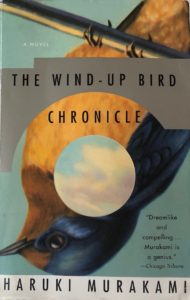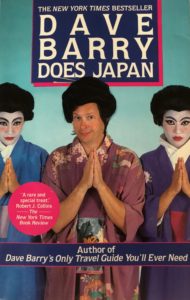
Japan: Samurai Swords, Wind-Up Birds, and Clever Cats

Our penchant for travel might just be an excuse to read.
Before departure day we scour second-hand stores, download travel guides, and track down hard-to-find titles through online sources. Some ‘free’ travel titles come with an Amazon Unlimited subscription, $10/month – lots of Lonely Planet guides there, FYI.
We read relentlessly before departure day, then tuck a few books (light ones) in the luggage and load up the rest on I-Pads. Our March 2018 journey includes several days at sea, days I’ll be curled up with a good book in one of the delightful hideaways scattered around our cruise ship. (A future blog post in the making, right there.)
In the hunt for good stuff, I search for best books to read before you visit (name of country/city) and see what comes up. Pretty fast I find the ‘must’ books for a destination, but the best books for one reader (even two married readers, if our experience is any indication) are not necessarily the same for another.
We like what we like, and my reading preferences range from critically acclaimed literary works (The Wind-up Bird Chronicles) to the definitely-not-literary but just plain fun (Dave Barry Does Japan), to literary AND hilarious (I can’t get enough of the 1906 Japanese classic, I Am A Cat). So here’s my annotated, admittedly idiosyncratic Japan prep reading list, not a ‘best of the best’ by any means. I plan to add to it as I finish more titles.

The Wind-Up Bird Chronicles, by Haruki Murakami, 1997. 607 pgs.
★★★★★ 5 stars for literary quality
★★ 2 stars easy read (Not. No drifting off.)
Any book that starts with a lost cat – in sprawling Tokyo, no less – has my attention from the start.
At first, Murakami’s tale seemed to be about a 30-something disaffected guy who half-heartedly dropped out of Japan’s infamous salarymen culture, where employees sometimes work themselves to death for their corporate overlords. It’s a little bit that, but so much more. Things turn odd quickly in a scifi cyberpunk way, with mysterious phone calls, real-life nightmares, and surreal journeys into Japan’s underbelly, both present and past.
Or maybe not.
Murakami constantly crosses the line between reality and imagination. Once we notice the recurring bird cry calling from the darkness (that can’t be good), we’re deep down in Murakami’s inexplicable world. And did I mention the psychic prostitute? Or the wig-factory worker girl who is obsessed with death? And that Murakami makes me laugh out loud sometimes?
Weird, just like life I guess. The Wind-up Bird is a riveting detective story, one that explores the angst of modern life as well as the brutality of war, with precision and artful perfectness.
But reader beware; you have to work for this one.
A Tale for the Time Being, by Ruth Ozeki, 2013. 418 pgs

★★★★★ 5 stars for Zen Buddhist-style reflections on time, memory, and the meaning of life. (Ozeki is a real-life Buddhist priest, so it figures.)
★★ 2 stars if you want a pat ending. Spoiler alert; not happening here. Starts with Proust, ends with the story’s mysteries (and life’s) still resonating.
A barnacle-encrusted plastic baggy washes up on a desolate Pacific Northwest island beach, mixed in with trash that may have floated all the way from Japan in the wake of the devastating 2011 earthquake and tsunami.
When a beachcomber opens the baggy, she finds a suicidal Japanese schoolgirl’s secret diary inside a Hello Kitty box, and an antique watch. The diary’s author has attempted to conceal its true provenance by hiding it under a fake book jacket of Marcel Proust’s In Search of Lost Time.
So we have layers upon layers, an apt description for this captivating story.
The beachcomber, a writer of Japanese ancestry herself, searches for clues to the diarist’s identity and fate in an understandable but impossible desire to help. Her search yields meditations into our shared humanity and interconnectedness, time and memory, relationships, and all the life stuff I like to think about, especially when I’m travelling or getting ready to travel.
This book touched me deeply no doubt because it so beautifully connected my life on a Pacific Northwest beach to the people of Japan, despite the ocean between us. Yet I’m confident everyone will appreciate this expertly crafted story, not just Pacific Northwesterners. Since its 2013 publication, it has won several literary awards.
I Am A Cat, by Natsume Soseki, 1906. 471 pages

★★★★★ 5 stars for featuring a cat
★★★★★ 5 stars for spot-on portrayals of humans (and cats) in all their endearing, exasperating variations
Soseki’s satirical novel began as a series of magazine installations he wrote in 1905-1906. So each chapter can stand alone, perfect for a quick read before bedtime.
The cat-without-a-name makes himself at home in his owner’s Meiji Restoration period home, then shares his observations of an assortment of cats and humans, like this one of the neighborhood bully cat, Emperor:
He seemed well fed and positively prosperous, almost obese, in his oily glossiness…Savagely twitching his ears, ears as sharp as slant-sliced stems of the solid bamboo, he took off rowdily.
Or this one, that makes me think of a current prominent public figure in particular:
Blacky, like all true braggarts, is somewhat weak in the head. As long as you purr and listen attentively, pretending to be impressed by his rhodomontade, he is more or less a manageable cat…..So without making a fuss, I sought to lead him on by saying, ‘You, judging by your age, must have caught a notable number of rats?’ Sure enough, he swallowed the bait with gusto.
I am so glad I’m not done with this book yet. I’m going to savor it.
Shogun, by James Clavell, 1975. 1152 pgs.

★★★★★ 5 Stars for plot
★ 1 Star for brevity
Well of course I had to reread Shogun. This historical fiction classic centers on swashbuckling Captain James Blackthorne, loosely based on a real historical figure.
I last read Shogun in 1976, a lifetime ago. All I remembered was sword-wielding samurai around every corner, and female samurai. Still quite rare to see female fighters back then, long before Wonder Woman showed us how to fight like girls. So it stuck with me.
And it’s held up quite well. Even the finicky New York Times book reviewers gushed a bit about it: “It’s not only something that you read – you live it” while also noting that it’s long and exhausting. Also true.
So a few pages into Book One a samurai swiftly slices off a man’s head with blood spurting as the toppled head rolls away, another man is slowly boiled alive, and this gripping tale of 1600s feudal Japan is off to the races.
Master storyteller Clavell spins a captivating tale, centered on archetypal themes such as the hero’s journey, the clash of civilizations, and good versus evil. And it’s worth it to keep turning those pages: A steamy romance figures in the plot, and eventually, ninja assassins show up.
Clavell helped me remember what I already knew about Japan, which wasn’t much before we chose our March 2018 itinerary. While today Shogun is criticized for inaccuracies and isn’t on top of anyone’s literary canon, I loved it (even though I did skim the long parts). It brought Japan’s medieval feudal system to life for me, which I’ll appreciate when we visit historical sights from the feudal period such as Osaka Castle.
Dave Barry Does Japan, by Dave Barry, 1992. 210 pgs.

★★★★★ 4 stars for pretty darn funny
★1 star for mercilessly exploiting cultural clichés
Despite the clichés (chopsticks, sumo wrestling, karaoke), Barry still taught me some things I didn’t know, such as not to tip or blow my nose in public, or how impossible it is to decipher a Japanese street sign – not going to happen, so we’re going to plan B, whatever that is.
Sometimes I just need to laugh and hit the lighter stuff, and Barry has a way of delivering his groaners that sets me to chuckling. He spent only three weeks with his family travelling around Japan on his publisher’s dime in 1992, which may explain his reliance on clichés.
And some of his observations are outdated simply because time has moved on. Barry’s implication that the United States is far superior to Japan in terms of pop culture? Not so much: Think anime and manga, just two examples of Japan’s recent explosion onto the world’s pop culture stage.
The serious Dave Barry peeks out in chapter 10, when he drops the comedian persona to tackle the Hiroshima question. One observation from that chapter:
I guess all politicians, from all over the world, attend some school where they learn how to reduce anything – anything – to verbal sludge. Granted, it has to be difficult for politicians to talk about Hiroshima, because what can they say? Maybe they shouldn’t say anything.
In 2018, I’d say that’s still relevant.
A Gateway to JAPAN, by June Kinishita and Nicholas Pelevsky, 1992. 526 pgs.

★★★★★★ 6 stars for historical and cultural background on specific sites
★ 1 star for up-to-date information on anything but history and ancient stuff. It was written in 1992.
I wanted to make sure obsessive travel researchers knew about this travel guide. It’s old and I almost didn’t get it, but noted the online raves and ordered it. So glad I did.
What makes it different than any modern guide I’ve read: Very detailed, accurate* descriptions of every old temple, shrine, city, park – you name it – we plan to visit in Japan, down to the meaning of the inscriptions over a shrine’s entry to the intricacies of object placement in a Zen Buddhist garden to the historical origins of (fill in the blank). A travel-obsessive’s classic!
I’m going to desecrate my copy by tearing out applicable sections to have on hand as we visit each place.
*Do make sure to note my 1-star rating: Definitely NOT for up-to-date information such as how to find an ATM in Tokyo.


